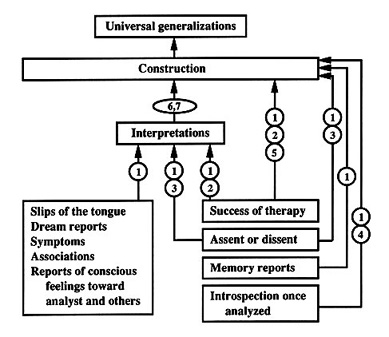(1) Only psychoanalytic interpretation and treatment can yield correct insight into the unconscious causes of a patient's neurosis.
(2) Only the patient's correct insight into the unconscious causes of the patient's neurosis can cause a durable cure of this neurosis.
Using simple logic, these premises can be reduced to the following form:
(1) IF NOT Psychoanalytic interpretation, THEN NOT Correct insight.
(2) IF NOT Correct insight, THEN NOT Durable cure.
Logically, these premises can be further reduced, and a conclusion drawn:
(2) IF Cure, THEN Insight.
(1) IF Insight, THEN Psychoanalysis.
____________________________________
(3) IF Cure, THEN Psychoanalysis.
This conclusion (3) is called the Necessary Condition Thesis (NCT), or "Freud's Master Proposition": Psychoanalysis is necessary for a durable cure of psychoneurosis. (A psychoneurosis is a mental disorder caused by repressed infantile experiences.) The consequences of the NCT can be deduced as follows:
(3) IF Cure, THEN Psychoanalysis.
(4) NOT Psychoanalysis.
____________________________________
(5) NOT Cure.
The NCT could potentially be falsified if a durable cure of psychoneurosis occured in the absence of psychoanalysis, e.g., if another form of therapy (or simple suggestion, or spontaneous remission) were shown durably to cure psychoneurosis.
The weakness of the tally argument is that, as Freud admits, patients are subject to suggestion (transference). Transference affects all clinical data. Therefore, all clincial data are suspect, including the insight that supposedly intervenes between psychoanalysis and cure.

LEVELS
PROBLEMS
Grünbaum, A. (1984). The foundations of psychoanalysis: A philosophical critique. Berkeley, CA: University of California Press.
Von Eckardt, B. (1986). Grünbaum's challenge to Freud's logic of argumentation: A reconstruction and an addendum. The Behavioral and Brain Sciences, 9, 262-263.
Last modified January 1999
Visited times since July 2001
Comments?
Home to Psychoanalysis
Home to Great Ideas in Personality